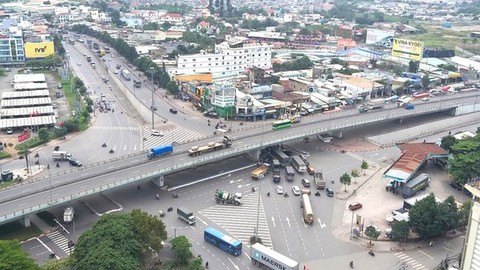
The Vung Tau intersection (between Highway 1 and Highway 51) in the southern key economic region is always congested. Photo sggp.org.vn
Localities in the southern key economic region need to set up an “investment fund” to develop transport infrastructure to enhance connectivity in the region to ensure sustainable growth, experts have said.
The funding, to be used for technical assistance projects, construction of road infrastructure, technology and logistics centres and human resource training, could be sourced from the Government, provinces and cities as well as from local and foreign investors, they said.
Speaking at a recent conference, a member of the Government’s economic advisory team, Tran Dinh Thien, said poor regional connectivity across land, air and sea had hindered the growth of the region.
The region remained the leader in terms of share of GDP, Government revenues and other economic factors, he said.
With better connectivity, provinces and cities in the region would be able to take advantage of the shift in global investment flows in future and attract large high-tech investments to create value chains, he said.
However, in 2016-18 the region’s economy grew at 6.81 per cent against the 9.08 per cent achieved by the northern key economic region, and this was because of its poor connectivity, with ring roads and highways not being built or built too slowly, he said.
The region only has 91km expressway, or 11 per cent of the country’s total.
Tan Son Nhat International Airport in HCM City is increasingly overloaded while the Cai Mep-Thi Vai seaport is operating above capacity and a system of roads and railways leading to and from its terminal is lacking.
Recommendations
Tran Hoang Ngan, director of the Institute for Development Research of HCM City, told the meeting that a critical problem was the lack of awareness of the benefits of intra-region transport infrastructure connectivity.
“The region should establish a shared database the entire region can use.”
The interests of various localities in the region had not been “harmonised” enough, he said.
The region must prioritise resources for developing ports, airports and roads linking ports.
Deputy Minister of Transport Le Anh Tuan said investing in the region’s transport infrastructure would play a major role in the overall development of the country.
His ministry would continue to work with agencies to advise the Government on how to raise capital to fund regional connectivity, he promised.
The ministry had submitted to the Government a VND54 trillion (US$2.32 billion) proposal for regional transport infrastructure connectivity for the south-east region, he said.
Prime Minister Nguyen Xuan Phuc recently instructed the Ministry of Transport to prioritise major projects in the region over the next five years such as the Can Tho - Ca Mau Expressway.
He also instructed the ministry to seek private funding for the HCM City - Trung Luong - My Thuan - Can Tho - Ca Mau highway.
He ordered the completion of the Trung Luong – My Thuan Expressway and its opening to traffic next year.
There are 11 highways planned for the region with a total length of 970km, but experts said implementation of the work is too slow.
It was envisaged 497km will be completed and used this year but only 122km have and another 278km are being built.
Comprising HCM City and the six provinces of Ba Ria-Vung Tau, Dong Nai, Binh Duong, Binh Phuoc, Tay Ninh, and Binh Thuan, the southern key economic region spreads over 31,300sq.km and has a population of 19.6 million.
Bordering the East Sea, it is rich in resources and enjoys favourable climate conditions. — VNS